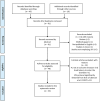Systematic Review and Methodological Considerations for the Use of Single Prolonged Stress and Fear Extinction Retention in Rodents
- PMID: 34054443
- PMCID: PMC8162789
- DOI: 10.3389/fnbeh.2021.652636
Systematic Review and Methodological Considerations for the Use of Single Prolonged Stress and Fear Extinction Retention in Rodents
Abstract
Posttraumatic stress disorder (PTSD) is a mental health condition triggered by experiencing or witnessing a terrifying event that can lead to lifelong burden that increases mortality and adverse health outcomes. Yet, no new treatments have reached the market in two decades. Thus, screening potential interventions for PTSD is of high priority. Animal models often serve as a critical translational tool to bring new therapeutics from bench to bedside. However, the lack of concordance of some human clinical trial outcomes with preclinical animal efficacy findings has led to a questioning of the methods of how animal studies are conducted and translational validity established. Thus, we conducted a systematic review to determine methodological variability in studies that applied a prominent animal model of trauma-like stress, single prolonged stress (SPS). The SPS model has been utilized to evaluate a myriad of PTSD-relevant outcomes including extinction retention. Rodents exposed to SPS express an extinction retention deficit, a phenotype identified in humans with PTSD, in which fear memory is aberrantly retained after fear memory extinction. The current systematic review examines methodological variation across all phases of the SPS paradigm, as well as strategies for behavioral coding, data processing, statistical approach, and the depiction of data. Solutions for key challenges and sources of variation within these domains are discussed. In response to methodological variation in SPS studies, an expert panel was convened to generate methodological considerations to guide researchers in the application of SPS and the evaluation of extinction retention as a test for a PTSD-like phenotype. Many of these guidelines are applicable to all rodent paradigms developed to model trauma effects or learned fear processes relevant to PTSD, and not limited to SPS. Efforts toward optimizing preclinical model application are essential for enhancing the reproducibility and translational validity of preclinical findings, and should be conducted for all preclinical psychiatric research models.
Keywords: animal model; extinction retention; fear memory; posttraumatic stress disorder; prospective stress; reproducibility of results; single prolonged stress.
Copyright © 2021 Ferland-Beckham, Chaby, Daskalakis, Knox, Liberzon, Lim, McIntyre, Perrine, Risbrough, Sabban, Jeromin and Haas.
Conflict of interest statement
CF-B, LC, AJ, and MH are employed by Cohen Veterans Bioscience, a nonprofit 501(c)(3) research organization. ND has held a part-time paid position at Cohen Veterans Bioscience, has been a consultant for Sunovion Pharmaceuticals and is on the scientific advisory board for Sentio Solutions. The remaining authors declare that the research was conducted in the absence of any commercial or financial relationships that could be construed as a potential conflict of interest.
Figures




References
-
- American College of Laboratory Animal Medicine Series (2020). The Laboratory Rat, 3rd Edn, eds Suckow M. A., Hankenson F. C., Wilson R. P., Foley P. L. (San Diego, CA: Academic Press; ), 2.
Publication types
Grants and funding
LinkOut - more resources
Full Text Sources
Other Literature Sources

